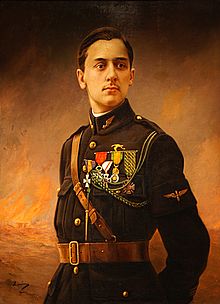Georges Guynemer

Georges Guynemer (born December 24, 1894 in Paris , † September 11, 1917 ) was a French fighter pilot during the First World War . He recorded 53 victories and was shot down a total of seven times.
Life
Georges Marie Ludovic Jules Guynemer came from a rich family in Compiègne . He was a sickly child and was later deferred from military service. In 1914, however, he was employed as a mechanic. Due to his high level of self-confidence and perseverance, he was eventually admitted to pilot training in Avord . In June 1915 he was assigned to the Escadrille MS.3, which became known as the Escadrille des Cigognes . He flew Nieuport , SPAD and Morane-Saulnier planes, with which he won numerous aerial victories, but was also shot down several times.
After attending elite school No. 3 in 1916, he quickly became one of the most successful fighter pilots. When he was shot down for the fifth time in February 1916, he officially became a so-called flying ace and in March he was promoted to lieutenant . At the end of 1916, 25 kills were confirmed to him. Soon after, he was appointed squadron commander. His militarily most successful month was May 1917, in which he shot down seven German planes. In July of the same year he became the first Frenchman to record 50 victories.
The German flying ace Ernst Udet liked to tell the following anecdote about the chivalry of the aviators sometimes exercised during the First World War : According to Udet's report, Guynemer fought doggedly with the German in June 1917, but, despite his superiority, did not shoot him down when he noticed that Udet jammed. So Guynemer flew to Udet's plane, tossed him a chivalrous greeting, and then disappeared again over Allied territory. The interpretation probably also preferred by Udet was that the fighter pilots saw themselves as modern knights of the sky. They did not want to be lacking in fairness and chivalry in the fight with the enemy . According to the pilots' unwritten code of honor , fighting a defenseless enemy was also considered dishonorable. However, there is no description of this incident by Georges Guynemer.
On September 11, 1917, Guynemer was killed during an operation in West Flanders . He had separated from his wingmen and attacked a German observation aircraft. According to German reports, he was shot down by Kurt Wissemann from the Jasta 3. Guynemer fell south of Poelkapelle, in the sector of the 413 Infantry Regiment of the 204th Infantry Division . Lieutenant Eugen Wendler, adjutant of the standby battalion, found the body a few hundred meters from his command post and took the papers, a boot and a piece of the belt. The papers were later given to the French authorities, the family's personal property. What happened to Guynemer's body has never been clearly explained by the German side. The traditions of four Belgians from autumn 1917, who independently describe a body wrapped in leather, are the only reliable references so far. For a long time it was said that the famous French fighter pilot René Fonck had avenged his missing comrade, but Lieutenant Kurt Wissemann was probably shot down on September 28, 1917 after five aerial victories by a plane of the British Royal Flying Corps .
The death of the popular, press-acclaimed Guynemer was received with dismay in France. The school children were told that he had flown his plane so high "into the sky" that he could not return. Throughout the war he was hailed as a hero and an inspiration to the nation; publications such as Henry Bordeaux's Vie héroïque de Guynemer, le chevalier de l'air from 1918 appeared.
After the end of the war
In the Belgian town of Langemark-Poelkapelle (West Flanders), a memorial in honor of the aviator was erected after the war. On the top of the pillar is the image of a stork flying in the direction of the German lines.
literature
- Jules Roy: Guynemer, l'ange de la mort. Albin Michel, 1986.
- Spencer C. Tucker : Guynemer, Georges Marie Ludovic Jules. In: ders. (Ed.): World War I: The Definitive Encyclopedia and Document Collection. Vol. 1: A-C. ABC-Clio, Santa Barbara, CA, Denver, Oxford 2014, p. 722 f.
- Ian Sumner: Kings of the Air: French Aces and Airmen of the Great War. Pen & Sword Books, Barnsley 2015 (passim).
Web links
- Pilot blog: Georges Guynemer . In: PilotBlog
Individual evidence
- ^ Spencer C. Tucker: Guynemer, Georges Marie Ludovic Jules. In: ders. (Ed.): World War I: The Definitive Encyclopedia and Document Collection. Vol. 1: A-C. ABC-Clio, Santa Barbara, CA, Denver, Oxford 2014, p. 722 f., Here p. 723.
- ^ Ian Sumner: Kings of the Air: French Aces and Airmen of the Great War. Pen & Sword Books, Barnsley 2015, p. 126; ; Norman Franks: Dog-Fight: Aerial Tactics of the Aces of World War I. Greenhill Books, Barnsley 2003, p. 112 (2016 edition).
| personal data | |
|---|---|
| SURNAME | Guynemer, Georges |
| BRIEF DESCRIPTION | French fighter pilot during the First World War |
| DATE OF BIRTH | December 24, 1894 |
| PLACE OF BIRTH | Paris |
| DATE OF DEATH | September 11, 1917 |
| Place of death | West Flanders |

